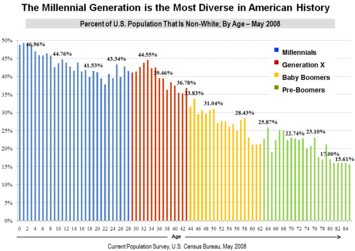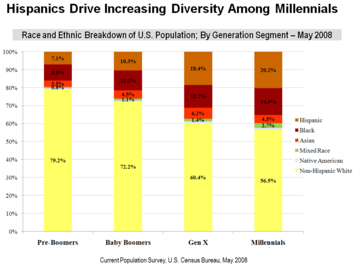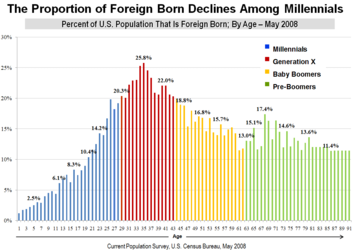
One of the most widely observed, yet least understood, attributes about the emerging Millennial generation is their ethnic and cultural heterogeneity. While they represent the most ethnically varied cohort in American history—far more than any previous U.S. generation—few social commentators actually agree on what this remarkable demographic detail really portends. Will Millennials usher in a new post-ethnic America—or simply reconfigure some different version of identity politics? Will they carry on the mantle of the civil rights movement—or eliminate antiquated racial-ethnic categories altogether? Are they even cohesive enough as a group to assert any meaningful, broad-based cultural agenda?
Whatever paths they pave, one thing is certain: Millennials are poised to fundamentally reshape the way America has historically thought about race—and, as a result, will likely reconceive our nation’s own ethnic and cultural self-identity in the process.

By their sheer numbers, Millennials are already reshaping the nation’s ethnic makeup. Not only do they represent a “baby boomlet” in terms of population size, but according to recent figures from the 2008 Current Population Survey, 44 percent of those born since the beginning of the 80’s belong to some racial or ethnic category other than "non-Hispanic white". Millennials are revealing themselves to be the demographic precursor to Census Bureau projections showing whites as a minority by 2050. Slightly more than half of Millennials—56 percent—are white (non-Hispanic). Age itself is inversely correlated to diversity levels—the younger in age, the higher the proportion of “ethnic” populations within each age bracket. Contrast these figures to the 28 percent of current Baby Boomers who are non-white, and one begins to see a profoundly different look and hue for future generations of Americans to come, led by Millennials.

Undeniably, Hispanics are at the forefront of this Millennial diversity. Slightly more than 20 percent of Millennials are Hispanics—twice as large as their Baby Boomer counterparts. Millennials also encompass a significantly larger share of Black and mixed-race folks than previous generations, but Hispanics are the driving force fueling the Millennial-led ethnic demographic makeover. Accelerated Hispanic population growth over the past several decades have provoked dire warnings about the perils of Hispanic immigration—threatening to “divide the United States into two peoples, two cultures, and two languages,” in the words of Harvard political scientist Samuel Huntington.
Yet nothing could be further from the truth—particularly when it comes to Hispanic Millennials. Approximately 86 percent of Hispanics under the age of 18 are in fact born in the U.S. (as a whole, 95 percent of Millennials are U.S. born). Many are the offspring of immigrants, but their birthright is firmly rooted in the United States. Unlike their immigrant parents, this group strongly exhibits a preference for English as their primary mode of communication. According to the Pew Hispanic Center, 88 percent of second generation Hispanics and 94 percent of third generation Hispanics are highly English fluent (speak “very well”). Many second generation Hispanics tend to be bilingual, but English dominates by the third generation.

Broadly speaking, a distinguishing characteristic of multi-ethnic Millennials is their heavily “second generation” orientation (nearly 30 percent are children of immigrants). Since they are more likely children of immigrants than immigrants themselves, the proportion of foreign born Millennials is relatively small compared to their immediate generational forebears: Generation X and Baby Boomers. Foreign-born persons comprise 13 percent of all Millennials (includes all those born since the 80s), but they make up 22 percent of the Generation X cohort (born between 1965 to 1979) and 16 percent of Baby Boomers (born between 1946 and 1964).
Given their more varied disposition, it should hardly be surprising that Millennials are blurring the color lines that have long-marked previous American generations. According to market research firm Teen Research Unlimited, 60 percent of American teens say they have friends of different ethnic backgrounds. More telling, however, is a 2006 Gallup Poll showing that 95 percent of young people (ages 18 to 29) approved interracial dating—compared to only 45 percent among respondents over the age of 64. Likewise, a USA Today/Gallup Poll conducted last year among teens showed that 57 percent have dated someone of another race or ethnic group—up 40 percent from when Gallup last polled teens the question back in 1980.
Perhaps more astounding is the casual mix-and-match cultural sensibilities of Millennials. Not content to cleave to any single ethnic or cultural influence, they are free to engage in the variety with no restrictions. One example is “Mashups”—entire compositions reconfigured from samples drawn from disparate musical genres—so popular on mp3 players. Millennial choices in popular culture are drawn from a broad pool of influences, and anything can be customized and suited to one’s personal preferences—just as easily as an iPod playlist. Likewise, the aesthetics of Millennial fashion, movies, and video games increasingly reflect a broad range of influences—from Japanese anime to East L.A. graffiti art.
In my own marketing research and consulting practice, I’ve been able to witness firsthand the eclectic, dynamic nature of Millennials, usually behind a focus group window (our firm focuses on ethnic consumers for a range of Fortune 500 companies). Increasingly, today’s young consumer shun direct overtures aimed at appealing to their ethnic background. Similarly, they tend to discard traditional cultural labels in favor of their own self-created monikers like “Mexipino”, “Blaxican”, “China Latina”.
As a market segment, Millennials represent a precarious consumer. In the marketing world, they are shaking the foundations of advertising and media. Enabled by technology, they are contributing to a fragmented media landscape that grows ever more disparate and porous. Forced to keep up, advertisers question whether they can ever again rely on traditional media to broadcast messages for a lifestyle characterized by instant text messaging, mobile media, and virtual social networking.
But beyond the business challenges posed by this growing crop of emerging consumers, the most lasting social contribution of Millennials is not likely the next media or pop culture trend, but how they—by simple virtue of who they are— will redefine race and ethnicity for the rest of America.
Thomas Tseng is a principal at New American Dimensions, a multi-cultural marketing firm based in Los Angeles.












